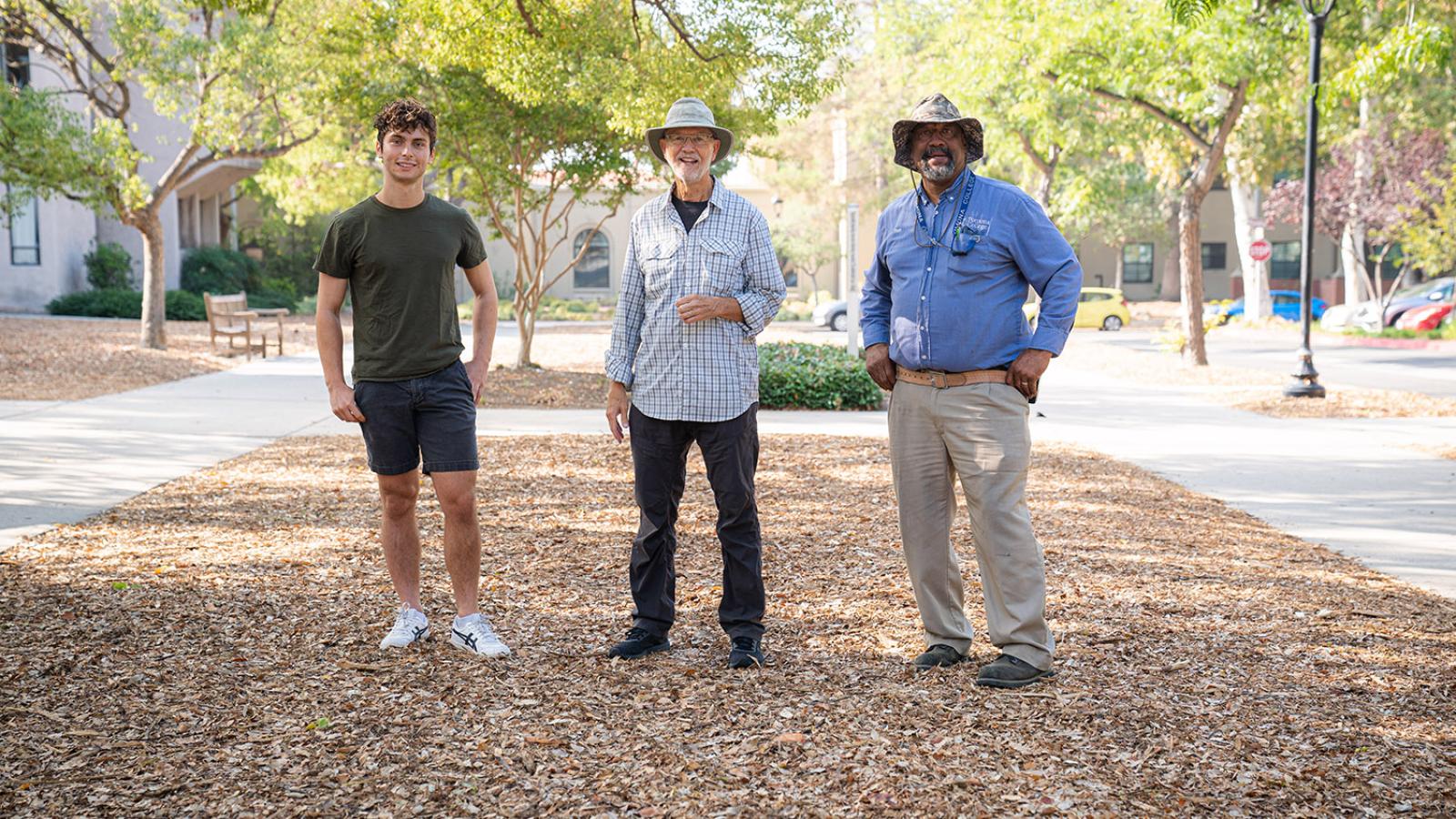At a time when California was experiencing megadrought and landscape water restrictions lay just ahead, Pomona College student Jacob Greene ’23 saw opportunity. Looking around campus at large expanses of grass, he wondered if some of it could be converted to a low-water alternative. More importantly, he mused, would the campus community get behind the effort?
Alexis Reyes, Pomona’s director of sustainability and energy management, notes that since 2014, the College had already replaced 161,000 square feet of grass with a water-saving landscape design. “The grounds staff thought they had done as much as community members would allow them to do,” Greene remarks. What remained, the thinking went, was all “programmable space” where students studied, activities took place and grass was indispensable.
Greene wanted to put conventional thinking to the test. His aim was “to involve students, faculty and staff in the landscape decision-making process and see if they wanted to save a little bit more water.” A grant from the College’s President’s Sustainability Fund in fall 2021 covered expenses and a small stipend. Greene mapped areas of the campus where landscape change might be possible and developed an online survey. “The fact that 214 students replied to my little survey blew my mind,” he says. It “really made me feel supported in the project.”
By spring, Greene was ready to share his findings with campus grounds manager Ron Nemo and the College’s sustainability committee, which Reyes leads. He had identified at least 17,000 more square feet of grass which the college community would support converting to low-water landscape.
Within weeks, Reyes and Nemo had gotten the project underway. “I didn’t know that my recommendations were actually going to be implemented,” says Greene. “That was super exciting to see.”
Grass wasn’t the only area in which the environmental analysis major saw his recommendations yield results. A second project looked at how lighting could be made more efficient in parking structures. Campus facilities staff knew it was a problem; “they just needed a little bit of a push,” says Greene. “I encourage other students to get involved and continue making this campus more sustainable and healthier for the environment.”
Progress toward sustainability goals
A walk through campus with Reyes, Nemo and Char Miller, W.M. Keck Professor of Environmental Analysis and History, shows a variety of ways the campus is making strides toward its 2030 sustainability goals. Among them are to reduce water use by 60% from the 2014 baseline and to achieve carbon neutrality. Irrigation across campus has been reduced to one day a week, and a “smart irrigation” system adjusts to real-time weather conditions, Reyes says. The turf that remains is a special low-water blend comprised of kikuyu and Bermuda grass with some dwarf fescue and perennial rye.
The College, in partnership with the City of Claremont, now uses 100% of green waste resulting from landscape maintenance. Ground into mulch, it creates a “thermal blanket” for plant roots, allows beneficial microorganisms to flourish and reduces the need for water. “It’s a nice biological loop,” says Miller.
Nemo is enthusiastic when he talks about one eco-friendly change that the campus community can see but not hear. Two new “Mean Green” lawn mowers bring the electric vehicle revolution to Pomona lawns. “They’re awesome!” he says—and quiet. The department also purchased four rechargeable electric leaf blowers. “With what’s going on in the industry, manufacturers can’t keep up with demand,” Nemo notes. “There’s no more in stock until December!”
Miller likes to walk the campus with students showing them invisible ways the campus is helping to refill local aquifers. On one sidewalk he asks them to take out their water bottles and pour water onto the concrete. “They look at me like ‘What is this guy talking about?’” he says--and the water goes straight into the ground. “The concrete is porous,” Miller explains. “We try to punch holes in concrete wherever we can. We have alluvial movement of water from the mountains down into the aquifers. We paved it over and stopped it. So, we’re trying to open it up wherever we can.”
Transition to solar power is one area where some of the College’s graceful older buildings have proven challenging. Solar arrays are “a very visible sign of sustainability,” says Reyes. “A lot of students pick up on that.” The roofs of older buildings, though, especially those with Spanish tiles, “just can’t hold the weight of solar.” Shading from the many trees also makes solar less feasible. “We’re working on adding more solar where we can” and looking at some creative ideas like putting solar over the bleachers in the athletics fields, she says.
“We’ve made a lot of progress,” says Reyes of the College’s efforts to be more sustainable. “The original landscape architecture was meant to mirror the East Coast and bring that to Claremont, and that became part of Pomona’s identity.” Now there’s been an evolution in student attitudes, as Greene’s projects demonstrate. “Students don’t really want the rose bushes or azaleas or ivy. They like seeing the butterflies and bees that come with native plants,” Reyes says. “It really gives you a sense of place for Claremont.”
